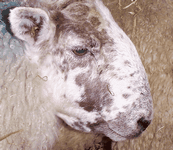NADIS Sheep Disease Focus – December 2006
| NADIS is a network of 40 veterinary practices and six veterinary colleges monitoring diseases of cattle, sheep and pigs in the UK. |
| NADIS data can highlight potential livestock disease and parasite incidences before they peak, providing a valuable early warning for the month ahead. |
| NADIS disease bulletins are written specifically for farmers, to increase awareness of prevalent conditions and promote disease prevention and control, in order to benefit animal health and welfare. Farmers are advised to discuss their individual farm circumstances with their veterinary surgeon. |
NADIS Sheep Disease Focus – December 2006
Liver Fluke (Fascioliasis)
Phil Scott DVM&S, CertCHP, DSHP, FRCVS
Acute, subacute and chronic liver fluke infestation has always been a problem in the wetter western areas of the UK but recently it has also become a major problem in eastern areas of the country. Slaughterhouse liver condemnations indicate that fasciolosis is widespread and increasing in frequency.
Fasciola hepatica has the liver as its site of infection in both cattle and sheep. The intermediate stages involve snails. This stage of the parasite life cycle requires moisture and an environmental temperature above 7 – 10 Celsius. A late spring early/summer infestation of snails results in an autumn fluke challenge to sheep. This causes immediate acute disease, subacute disease over the next few weeks, or chronic disease three months later depending upon the level of challenge.
Clinical presentation
Acute fasciolosis
Affected sheep die suddenly from haemorrhage and liver damage, with the first evidence of a problem being sudden deaths in up to 10% of previously healthy sheep from August to October . Others may be lethargic and reluctant to move. and reduced grazing activity.
Subacute fasciolosis
The major signs are rapid loss of body condition and poor fleece quality despite adequate flock nutrition. Some sheep will exhibit severe depression, inappetance, weakness, and may be unable to stand. Losses typically occur from December onwards but may be as early as October under severe challenge.
Chronic fasciolosis
Affected sheep are in very poor body condition with poor fleece quality and in many sheep, bottle jaw.

Affected sheep may die in an emaciated state especially when faced with the demands of advanced pregnancy/early lactation. Loss of the ewe and her lamb(s) can severely affect farm profits.
Diagnosis
Diagnosis of acute/subacute fasciolosis is based upon the epidemiological data (high risk year), and veterinary investigation of blood samples which reveals raised liver enzymes. Immature flukes are demonstrated in the bile ducts and gall bladder at postmortem.
Chronic fasciolosis is diagnosed by demonstration of fluke eggs in faecal samples. Mature flukes are demonstrated in the bile ducts and gall bladder. (Fig 4).
Treatment
Triclabendazole is highly effective at killing all stages of flukes responsible for acute fasciolosis. Drenched sheep should be moved to clean pasture or re-treated every three weeks for the next three months at least.
Nitroxynil and oxyclosanide are less effective against immature flukes and should be used only in the treatment of subacute and chronic fasciolosis. Once again, treated sheep must be moved to clean pastures.
Improved nutrition is essential.
Management/Prevention/Control measures
Infestations are controlled by strategic drenching based on veterinary advice. During low risk years triclabendazole is administered in advance of the predicted challenge during October and January, with another flukicide drug administered in May. In years with a high risk of fasciolosis, additional triclabendazole treatments are given in November and February. While it may be possible to eradicate fluke from a property, there are considerable risks from not drenching as the appearance of clinical disease in a few sheep represents serious losses in the whole flock. In certain areas wildlife hosts may play an important role in the disease dynamics.
Fencing off snail habitats is rarely practicable and in most situations is cost prohibitive as is drainage as these are often extensive sheep enterprises.
Economic importance
Fasciolosis can have a serious financial impact on a sheep farm with immediate losses of 5 to 10% caused by acute/subacute disease. Chronic disease could halve profits by reducing lamb crop and increasing ewe mortality. The role of health planning by the farmer’s veterinary surgeon is essential to maintain profitability and prevent losses.
Copyright © NADIS 2006 www.nadis.org.uk
FURTHER INFORMATION | SPONSORED LINKS |
| Supporting British Livestock |  |
| To find out more about EBLEX | |
| To find out more about the HCC |  |
| To find out more about QMS |  |
